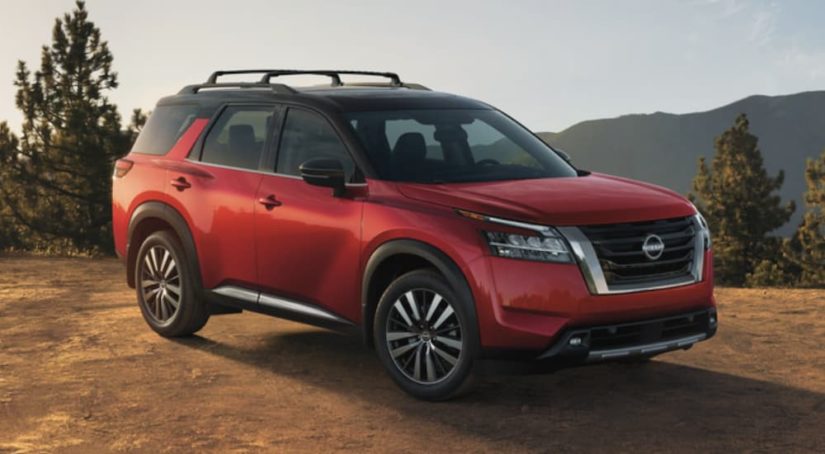In this day and age, the natural choice of vehicle for families is an SUV. It usurped the crown from both the minivan and station wagon some time ago as the definitive family vehicle. In my view, both the 2022 Nissan Pathfinder vs 2022 Honda Pilot are ideal SUVs for the family-oriented consumer—and we’re going to look at which model is more cost-effective.
Choosing which SUV is ideal for you and your family’s situation isn’t as cut and dry a decision as it might appear to be. Manufacturers offer several different models, trims, and varying sizes. Depending upon how large your family is and the location where you live, some models are better than others.
Of course, the biggest variable when it comes to purchasing the ideal SUV comes down to cost. Like most consumers, you probably live on a budget and have to stretch those pennies for all that they’re worth. That’s the reason we’re here today.
In an age where the economy and the price of gas are both wildly unpredictable, we need all the help we can get narrowing down our vehicle choices. Two contestants enter, and only one will remain. It’s the 2022 Nissan Pathfinder vs. the 2022 Honda Pilot in a fight to the finish. Which one is more financially practical?
MSRP and the Competition
I’m starting my comparison with the first place most people look when they go car shopping: the starting MSRP. While it’s no secret that there’s much more to the cost of ownership than the price on the windshield (which I’ll address later on), the MSRP is a good indicator of what ballpark you’re in as far as cost is concerned. Speaking of which, the Honda Pilot has a starting MSRP of $38,370. Compared to other three-row SUVs in its class, this price range could be considered somewhat moderate. It’s considerably cheaper than the higher-end luxury SUVs from Lincoln and Audi, but slightly higher than those offered by competitors Kia and Hyundai.
The 2022 Nissan Pathfinder starts for slightly less than Honda’s offering, with an MSRP of $33,410. Close in price with Kia’s hybrid model and significantly lower than well-known contenders from Chevy and Ford, Nissan offers a competitive rate that underbids many of its contemporaries. While the Pathfinder begins at a slightly higher price than the Hyundai Palisade and Kia Telluride, it exists in the same ballpark. This speaks to Nissan’s willingness to go head-to-head with their competitors: those who are known for offering vehicles at a highly competitive rate.

MPG, Milage, and Going the Extra Mile
If you own a vehicle that’s propelled by an internal combustion engine, then you’re quite familiar with the ritual of going to the gas station for a fill-up. Of course, this practice has gotten a little more difficult given current rates, which can range anywhere from appalling to inconvenient. Choosing a vehicle that can transport you, your family, and your cargo is essential; being cost-effective at the pump and getting the best MPG is one of the most important aspects of car ownership. I’ve broken down both vehicles to place an objective look at how each one delivers in these times of less-than-favorable fuel prices.
Some of the major determining factors in how effective a vehicle is with its fuel consumption all come down to the powertrain and drivetrain. Both the Nissan Pathfinder and Honda Pilot are equipped with 3.5-L V6 engines—an ideal compromise between the economical 4-cylinder engines that are associated with smaller-sized SUVs and the V8s used in full-sized SUVs and pickup trucks. One of the key differences in the powertrains in both vehicles is the choice of transmission. Honda has decided to equip the Pilot with a nine-speed automatic transmission, similar to the kind used in other vehicles in its class—such as the Chevy Blazer.
Nissan, on the other hand, has opted for the company’s CVT (Continuous Variable Transmission), which has been a major component of the other vehicles in their fleet—such as the Altima. The CVT has been proven effective in several smaller-sized vehicles and allows for moderate fuel consumption. This is due to its ability to keep its RPMs steady and consistent, even when traveling at different speeds. Because the powertrains of both vehicles are very similar to one another, the other variable of the equation must be taken into consideration. Drivetrains, such as AWD or FWD, play a significant role in how much an engine has to work to propel a vehicle forward.
I’ll begin with the FWD (sometimes called 2WD) versions of each vehicle. If you live in the city, suburbs, or a place where there are a lot of paved roads, a FWD SUV will be more than adequate for you and your family’s need for transportation. Between the Honda Pilot and Nissan Pathfinder, we again find a situation where both parties are almost equal. The Honda Pilot with FWD has a combined 22 MPG, which is nearly equal to the Nissan Pathfinder’s 23 MPG. However, there’s a unique difference when looking a bit more closely.
Because the FWD drivetrain is best utilized in a city environment, we need to evaluate the effectiveness of both vehicles in this area. The Honda Pilot’s MPG specs are as follows: While driving in the city, you can expect to achieve roughly 20 MPG. During highway driving, this number expands to 25 MPG. However, the Nissan Pathfinder holds an advantage in this area: the ability to gain 21 MPG within city limits and 26 MPG on the highway. While the difference might seem minimal on paper, every mile counts when the prices are as erratic as they are now.
Next, when I examine the drivetrains with 4WD, there’s no doubt who comes out on top as the winner. While a drivetrain such as this isn’t a necessity for everyone, those who live in climates with snowfall or expansive rural areas need that extra push when they’re on the road. The Honda Pilot, when equipped with AWD, has a combined 21 MPG. When properly broken down, this equates to 19 MPG when on the surface streets and 24 MPG when on the highway.
The Nissan Pathfinder with 4WD soundly beats the Pilot with a combined 23 MPG, thanks to its surface street 21 MPG and its highway number of 27 MPG. The EPA estimates that the average consumer could save as much as $500 per year in fuel costs if they opt for Nissan’s SUV.

Which One Is the Best Bang for Your Buck?
While this comparison was hard-fought and almost too close to call at certain points, I ultimately have to go with the 2022 Nissan Pathfinder. While Honda has certainly held an advantage in terms of popularity, the Pilot just can’t measure up to Nissan in terms of cost-effectiveness.
And, even when you break down other features of these two SUVs, they remain nearly equal contenders. Performance figures are very similar, and both offer one engine throughout the trimline. Sure, the Honda Pilot’s more generous cabin space is appealing, but so is the Nissan Pathfinder’s greater trailering capacity. In just about every other way but cost-effectiveness, these two SUVs are evenly matched.
For its lower starting MSRP and more conservative fuel consumption, the Nissan Pathfinder offers a cost-effective family vehicle. It’s affordable upfront and will allow you to start putting those pennies aside for future college funds.



